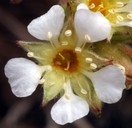Taxon Report
Ivesia sericoleuca (Rydb.) Rydb.Plumas ivesia |
 © 2003 Steve Matson |
Taxon Summary
Ivesia sericoleuca, commonly known as Plumas ivesia, is a perennial herb in the Rosaceae that is found only in California. It occurs within Great Basin scrub, Lower montane coniferous forest, Meadows and seeps, and Vernal pools, growing at elevations from 1310 to 2200 meters. Ivesia sericoleuca is ranked 1B.2, Plants Rare, Threatened or Endangered in California and Elsewhere; Moderately threatened in California.Classification
|
Scientific Name: |
Ivesia sericoleuca (Rydb.) Rydb. |
|
Common Name: |
Plumas ivesia |
| Family: | Rosaceae |
| Element Code: | PDROS0X0K0 |
| USDA Plants Symbol: | IVSE |
|
Synonyms/Other Names: |
|
Ecology and Life History
| Lifeform: | perennial herb |
| Blooming Period: May-Oct | May-Oct |
| Elevation: | 1310-2200 (4300-7220) |
| General Habitats: | Great Basin scrub, Lower montane coniferous forest, Meadows and seeps, Vernal pools |
| Microhabitat: | Vernally Mesic, Volcanic (usually) |
| Microhabitat Details: |
Conservation Status
| CA Rare Plant Rank: | 1B.2 |
| Global Rank: | G2 |
|
State Rank: |
S2 |
| State List: | None |
| Fed List: | None |
| Other Status: | BLM_S; SB_UCSC; USFS_S |
|
CRPR Changes: |
|
Occurrence Data from the CNDDB
| Total Occurrences: | 80 |
| Element Occurrence Ranks: | |
| Excellent (A) | 9 |
| Good (B) | 30 |
| Fair (C) | 11 |
| Poor (D) | 2 |
| None (X) | 1 |
| Unknown (U) | 27 |
| California Endemic: True | |
| California Counties and Islands: Name (Code) | |
| Lassen (LAS), Nevada (NEV), Placer (PLA), Plumas (PLU), Sierra (SIE) | |
| Quads: Name (Quad Code) | |
| Blairsden (3912075), Boca (3912041), Calpine (3912064), Crocker Mtn. (3912084), Dog Valley (3912051), Ferris Creek (4012013), Grizzly Valley (3912085), Hobart Mills (3912042), Independence Lake (3912043), Janesville (4012035), Martis Peak (3912031), McKesick Peak (4012012), Portola (3912074), Reconnaissance Peak (3912073), Sardine Peak (3912052), Sattley (3912054), Sierraville (3912053), Squaw Valley Peak (4012014), Truckee (3912032) | |
Threat List Data from the CNDDB
| Threat List Total: | 17 | |
| EOs with Threat Listed: | Total EOs | % of EOs |
| 59 | 74 % | |
| Grazing | 40 | 50% |
| Road/trail construction/maint. | 22 | 27% |
| ORV activity | 20 | 25% |
| Recreational use (non-ORV) | 9 | 11% |
| Development | 9 | 11% |
| Other | 8 | 10% |
| Erosion/runoff | 6 | 7% |
| Foot traffic/trampling | 6 | 7% |
| Non-native plant impacts | 5 | 6% |
| Surface water diversion | 3 | 3% |
| Logging | 3 | 3% |
| Dam/Inundation | 2 | 2% |
| Vandalism/dumping/litter | 2 | 2% |
| Agriculture | 2 | 2% |
| Altered flood/tidal/hydrologic regime | 1 | 1% |
| Disking | 1 | 1% |
| Landfill | 1 | 1% |
Citation
California Native Plant Society, Rare Plant Program. 2025. Rare Plant Inventory (online edition, v9.5.1). Website https://www.rareplants.cnps.org [accessed 23 December 2025].